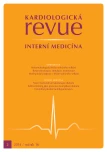Monitoring options for the circulation status and the influence of remote monitoring on heart failure
Authors:
M. Fedorco; M. Táborský
Authors‘ workplace:
I. interní klinika – kardiologická FN Olomouc
Published in:
Kardiol Rev Int Med 2014, 16(2): 102-105
Category:
Cardiology Review
Overview
Heart failure is a severe syndrome with high morbidity and mortality. Prognosis of these patients is poor and there are significant treatment expenses despite the progress in pharmacological and interventional treatment. One way to improve treatment and reduce morbidity and mortality lies in thorough patient monitoring to prevent episodes of heart failure worsening with the need for hospitalization. In addition to the standard outpatient examinations, there has recently been an increase in remote monitoring of objective parameters reflecting patients' circulation status. The manuscript is focused on a description of the current possibilities of remote monitoring and its influence on patients with heart failure.
Keywords:
heart failure – remote monitoring – ICD
Sources
1. Hradec J, Vítovec J, Špinar J. Summary of the ESC Guidelines for the diagnosis and treatment of acute and chronic heart failure 2012. Prepared by the Czech Society of Kardiology. Cor et Vasa 2013; 55: e25 – e40.
2. Stewart S, Jenkins A, Buchan S et al. The current cost of heart failure to the National Health Service in the UK. Eur J Heart Fail 2002; 4 : 361 – 371.
3. Goldberg LR, Piette JD, Walsh MN et al. Randomized trail of a daily electronic home monitoring system in patient with advanced heart failure: the weight monitoring in heart failure (WHARF) trial. Am Heart J 2003; 46 : 705 – 712.
4. Louis AA, Turner T, Gretton M et al. A systematic review of telemonitoring of the management of heart failure. Eur J Heart Fail 2003; 5 : 583 – 590.
5. Galbreath AD, Krasuski RA, Smith B et al. Long‑term healthcare and cost outcomes of disease management in a large, randomized, community based population with heart failure. Circulation 2004; 110 : 3518 – 3526.
6. Friedman MM. Older adults’ symptoms and their duration before hospitalization for heart failure. Heart Lung 1997; 26 : 169 – 176.
7. Stevenson LW, Perloff JK. The limited reliability of physical signs for estimating hemodynamics in chronic heart failure. JAMA 1989; 261 : 884 – 888.
8. BIOTRONIK Home Monitoring® Overview. [online]. Available from: http://www.biotronik.de/wps/wcm/connect/en_de_web/biotronik/sub_top/healthcareprofessionals/products/home_monitoring/#jump.
9. St. Jude Medical – Merlin™ Patient Care System. [online]. Available from: http://professional-intl.sjm.com/products/crm/connectivity-remote-care/connectivity/merlin-patient-care-system.
10. Boston Scientific – Cardiac Rhythm Resource Center. [online]. Available from: http://www.bostonscientific.com/cardiac‑rhythm resources/products.html#productDetailPage(10124672).
11. Medtronic – For Healthcare Proessionals. Medtronic CareLink Network for Cardiac Device Patients. [online]. Available from: http://www.medtronic.com/for-healthcare-professionals/products-therapies/cardiac-rhythm/patient-management-carelink/medtronic-carelink-network-for-cardiac-device-patients/index.htm.
12. Varma N. Rationale and design of a prospective study of the efficacy of a remote monitoring system used in implantable cardioverter defibrillator follow‑up: the Lumos ‑ T Reduces Routine Office Device Follow‑Up Study (TRUST) study. Am Heart J 2007; 154 : 1029 – 1034.
13. Crossley GH, Boyle A, Vitense H et al. The CONNECT (Clinical Evaluation of Remote Notification to Reduce Time to Clinical Decision) trial: The value of wireless remote monitoring with automatic clinician alerts. J Am Coll Cardiol 2011; 57 : 1181 – 1189. doi: 10.1016/ j.jacc.2010.12.012.
14. Mabo P, Victor F, Bazin P et al. A randomized trial of long‑term remote monitoring of pacemaker recipients (The COMPAS trial). Eur Heart J 2012; 33 : 1105 – 1111. doi: 10.1093/ eurheartj/ ehr419.
15. Eisner CH et al. A prospective multicenter comparison trial of home monitoring against regular follow‑up in MADIT II patients: additional visits and cost impact. In: Computers in Kardiology. Valencia: IEEE, 2006.
16. Saxon LA, Gates DL, Gilliam PA et al. Long‑term outcome after ICD and CRT implantation and influence of remote device follow‑up: the ALTITUDE survival study. Circulation 2010; 122 : 2359 – 2367. doi: 10.1161/ CIRCULATIONAHA.110.960633.
17. Hindricks G et al. The Influence of Implant ‑ Based Home Monitoring on the Clinical Status of Heart Failure Patients with an Impaired Left Ventricular Function. Amsterdam: ESC 2013.
Labels
Paediatric cardiology Internal medicine Cardiac surgery CardiologyArticle was published in
Cardiology Review

2014 Issue 2
Most read in this issue
- Centraly acting antihypertensives – rilmenidine
- Mechanical circulatory support in the treatment of cardiogenic shock – review
- Mechanical circulatory support and heart transplantation for treatment of chronic heart failure
- Non‑ pharmacological treatment of heart failure in terms of the new European guidelines for resynchronization therapy
